Red & BBs retirement home......
- Thread starter British Red
- Start date
-
Hey Guest, Early bird pricing on the Summer Moot (29th July - 10th August) available until April 6th, we'd love you to come. PLEASE CLICK HERE to early bird price and get more information.
You are using an out of date browser. It may not display this or other websites correctly.
You should upgrade or use an alternative browser.
You should upgrade or use an alternative browser.
Anything I think, just less likely to get the black mould/alge that grows on all my furniture that I treat with teak/tung oil.
Also the feet are a great idea if going on soil.
Also the feet are a great idea if going on soil.
Something new to try ths year. We want to try our hand at raising and threshing our own wheat.
For a number of reaons I want to try heritage, long stemmed wheats. This may be a dreadful mistake as we live in a flat, windy area - but I prefer growing open pollinated "save your own seed" varieties, and long stem wheats produce a better straw for baskets and thatch - so long stem heritage varieties it had to be.
Of course we then hit the problem of actually finding some! Could I get any? Not in this country I couldn't . I found one place in the US that did a lot of varieties. But they wouldn't ship here (sigh).
. I found one place in the US that did a lot of varieties. But they wouldn't ship here (sigh).
Enter Sniper69 from the USA who had them delivered to his home and shipped them on to me. What a star!!!
So the place to get them if you are interetsed is the Kusa society
http://www.ancientcerealgrains.org/seedandliteraturecatalog1.html
I bought a variety of older and interesting varieties. Each came with about 80 seeds. Given they need to be double planted 6" apart, it was about right for a 25' row of each variety.
I thought a brief description of the varieties we are trying would be interesting
Global 1506 is the one I have highest hopes for - but who knows?
Today was planting. I have rotvated the bed about a week ago. Spring wheat should be planted as soon as the ground can be worked but this Spring has been so cold and so wet and there was still snow about a week ago. So I am late, late, late. Given the seed was a hard thing to get, I could have wished for a better season, but I am chancing my arm and going for it.
With a nicely prepared seed bed (thank all thats holy for the wind and dry weather this last week), I sorted out my soil ridger, draw hoe, marking sting (ready made - the advantage of standardised beds), seeds and labels.

Tools by British Red, on Flickr
I marked up 3 rows 6" apart (the rows if drilling need to be 6" apart)

6 Inch Rows by British Red, on Flickr
The soil ridger hooks under the first string and I just walked along and pulled a neat 1.5" deep trench
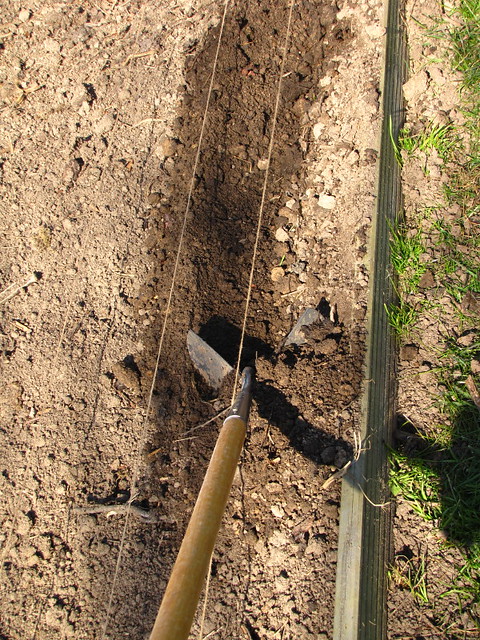
Soil Ridger by British Red, on Flickr
Time for the seeds. They need to be double drilled at 6" spaces. I hand sowed singly at 3" gaps - I'll thin if required but it allows for some failure to germinate. I labelled both ends of each row as part of this trial is to determine the best variety
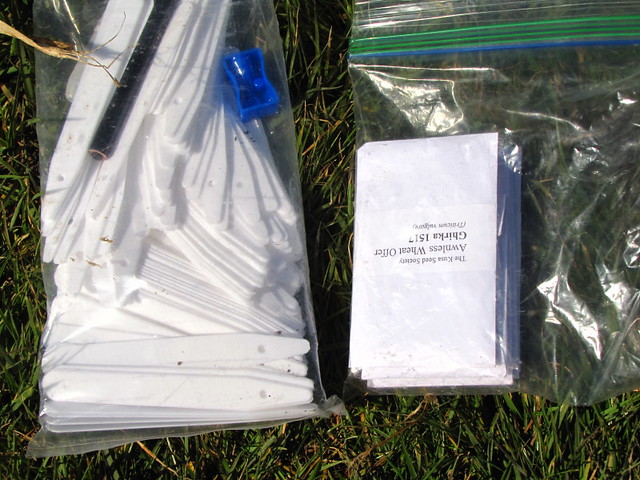
Heritage Wheat by British Red, on Flickr
It was very interesting when opening each seed packet to see how the varieties varied in shape and colour
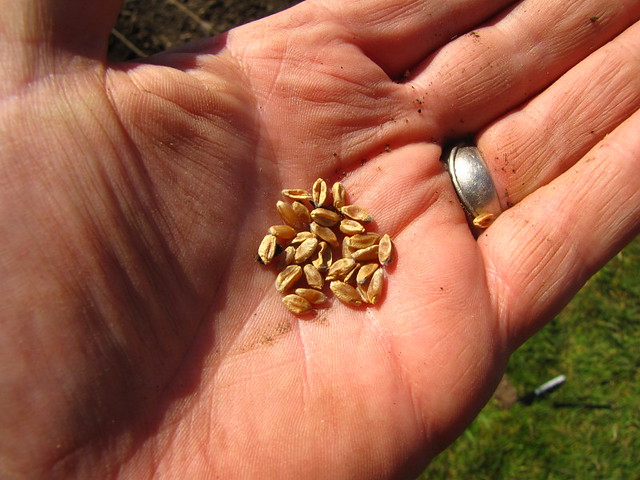
Red Fife by British Red, on Flickr

Globe Wheat by British Red, on Flickr
After sowing each row, I ridged the next row. This works very well as ridging row 2, covers row 1 and so forth. I'm a little human plough! After ridging row 2, I moved the string from row 1 across to row 4 and so on.
There we have it - 100 square feet of wheat, 7 varieties, 175 linear feet of rows.
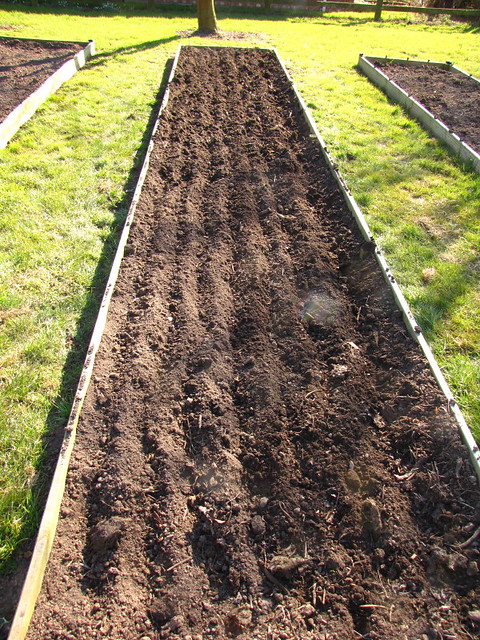
7 Rows of wheat by British Red, on Flickr
Given our windy conditions and the lack of "mutual support" from our long thin beds, I will build a wind break around the bed after germination.
Thats it for now - this is a very chancy test so we may get nothing - but its interesting to try and a good learning curve. My thanks again to Sniper69 for facilitating this
Red
For a number of reaons I want to try heritage, long stemmed wheats. This may be a dreadful mistake as we live in a flat, windy area - but I prefer growing open pollinated "save your own seed" varieties, and long stem wheats produce a better straw for baskets and thatch - so long stem heritage varieties it had to be.
Of course we then hit the problem of actually finding some! Could I get any? Not in this country I couldn't
Enter Sniper69 from the USA who had them delivered to his home and shipped them on to me. What a star!!!
So the place to get them if you are interetsed is the Kusa society
http://www.ancientcerealgrains.org/seedandliteraturecatalog1.html
I bought a variety of older and interesting varieties. Each came with about 80 seeds. Given they need to be double planted 6" apart, it was about right for a 25' row of each variety.
I thought a brief description of the varieties we are trying would be interesting
(Awnless Wheat)
The Awnless Wheat consists of five varieties of awnless wheat (Triticum vulgare). As noted by Percival (Wheats of Great Britain, 2nd Edn, 1948). Awns are scabrid and greatly irritate the eyes, nostrils, and tongues of cattle and horses to which such chaff is fed. In Great Britain and indeed western Europe generally, the wheats in cultivation are awnless because the chaff of awnless varieties is useful food for farm animals (while the grain is useful food for human).
GHIRKA 1517
Also known under the names Russian and Early Russian. This is a spring growth-habit wheat with hard grain, red kernel color and white chaff (glumes). It exhibited straw strength during the Kusa Seed organizations grow-outs with average plant height of 44 to a maximum of 65. It was exposed in the field in Ojai, California, to multiple nights of 16° F. at 30 days of age, with no harm to the seedlings. It arrived in the United States from the Volga River district of Russia. Thousands of acres of the grain were grown in western North Dakota around the last turn-of-the-century (1900). Its kernels are said to be larger and softer than Red Fife.
JAPHET
T. vulgare var. lutescens (Percival). This is a spring growth-habit wheat with yellowish-red kernel color. It exhibited straw strength during the Kusa Seed grow-outs with a plant height of 35-45. It is a British heritage variety. In England it was called Red Marvel and closely resembles Red Admiral. It was imported to England about 1904 from the famous seedhouse firm Messrs. Vilmorin in Paris, France, who selected it in 1892 for its good yields and other properties. This is a wheat from long before the days of herbicides, a wheat which made the artisan breads baked in the wood-fired ovens of France, in the days of carriages and candlelight, when food was still made by hand! The name Japhet is a christening originating with Messrs. Vilmorin.
PACIFIC BLUESTEM NO. 16
This is a spring growth-habit wheat with hard, white-color kernels. It is a descendant from the legendary White Lamma variety of England. White Lamma was the leading wheat variety when wheat production began in Australia. It exhibited straw strength during the Kusa Seed organizations grow-outs with average height of 60. It was exposed in the field in Ojai, California, to multiple nights of 16° F. at 50 days of age, with no harm to the seedlings. It was extensively grown in California about 100 years ago where it acquired a reputation for excellent baking quality. It was more extensively grown for a time in California than any other wheat variety, long before the age of chemical herbicides. Commercial production then spread to the states of Washington and Oregon. No one knows why the name bluestem was chosen for this variety, as the stems are not blue at all. To distinguish it from many other bluestem varieties, it was christened Pacific. It reached California from Australia about 1850.
RED BOBS
Red Bobs is a spring growth-habit wheat with hard, red-color kernels. Do Canadians know how to party? Never doubt that they do. With their big winters Canadians are masters of the wild weekend (sleep-over). According to official accounts, Red Bobs originated (discreet term) in a field of Bobs, a Canadian white wheat in the year 1910, probably as a result of a natural field cross. Red Bobs soon headed south however, crossing the border into the United States on a moonless night. So it came to pass that in 1924 the United States Department of Agriculture (USDA) wrote of Red Bobs: A first-class milling and bread-making wheat! (USDA Bulletin 1183). Party animal! Invite him for a sleep-over at your place! Red Bobs has dance steps you may not yet have seen.
RED FIFE
A spring growth-habit wheat with hard, red-color kernels. It exhibited weak straw strength during the Kusa Seed organizations grow-outs with plant heights of 40-71. It was exposed in the field in Ojai, California, to multiple nights of 16° F. at 50 days of age, with no harm to the seedlings. Accounts differ about its arrival in the United States. One states it arrived from Scotland, coming there from Danzig and Poland. Another states that the original came from Russia and Poland into Canada (1845), arriving in Wisconsin about 1860. It became the founder crop of the great flour industry of Minneapolis (Pillsbury, etc.) after the introduction of the roller-mill and the purifier. For some time it stood as the number one commercial hard spring wheat of the United States, commanding the highest price. (Roller-milling technology was stolen out of Hungary in an incident of industrial espionage [i.e. bald theft] and became the chief element in the commercialization of the United States flour milling industry; the end of whole, unrefined wheat flour and the come-uppance of white, purified wheat flour. See the Literature item in this Catalog, The Architecture of Whole Grain).
(Embassy Wheat)
The Embassy Wheats are very rare, individually spectacular wheats which flourished long before the age of chemical herbicides, when horse, mule, oxen, and human power ruled the fields.
BAART EARLY
Baart Early is a spring growth-habit wheat (Triticum vulgare) with large, semi-hard, white-color kernels and white glumes. It reached heights of up to 48 inches in the Kusa Seed organization growouts. Baart Early was imported into Australia from South Africa in 1880 and came to the United States in 1900. It became well established in Arizona, then spread to the Pacific Coast states.
About 500,000 acres were grown in 1919, while the 1939 records show 890,000 acres grown on the dry and irrigated lands of the West. A widely-grown, pre-modern bread wheat.
GLOBAL WHEAT STRAIN 1506
Globe Wheat (Triticum sphaerococcum) is a spring growth-habit wheat with small, spherical (round) kernels. The shape of the kernels is quite distinctive and memorable. The stems are very stiff on 24-inch plants whose leaves are all stiffly erect. The seeds have fast germination and emergence. Globe wheat filled the bread basket of pre-industrial colonial India where grain from the plants furnished the flour for the delicious native chapatis and countless other wheaten foods, probably for many long centuries. This crop tillers vigorously even when crowded and has an excellent agronomic appearance by modern plant-architecture standards. All heads have short awns. Start with a few seeds and get to 80-pounds with the third-generation harvest. The harvest from the 80-pounds will produce enough grain to feed a whole village
Global 1506 is the one I have highest hopes for - but who knows?
Today was planting. I have rotvated the bed about a week ago. Spring wheat should be planted as soon as the ground can be worked but this Spring has been so cold and so wet and there was still snow about a week ago. So I am late, late, late. Given the seed was a hard thing to get, I could have wished for a better season, but I am chancing my arm and going for it.
With a nicely prepared seed bed (thank all thats holy for the wind and dry weather this last week), I sorted out my soil ridger, draw hoe, marking sting (ready made - the advantage of standardised beds), seeds and labels.

Tools by British Red, on Flickr
I marked up 3 rows 6" apart (the rows if drilling need to be 6" apart)

6 Inch Rows by British Red, on Flickr
The soil ridger hooks under the first string and I just walked along and pulled a neat 1.5" deep trench

Soil Ridger by British Red, on Flickr
Time for the seeds. They need to be double drilled at 6" spaces. I hand sowed singly at 3" gaps - I'll thin if required but it allows for some failure to germinate. I labelled both ends of each row as part of this trial is to determine the best variety

Heritage Wheat by British Red, on Flickr
It was very interesting when opening each seed packet to see how the varieties varied in shape and colour

Red Fife by British Red, on Flickr

Globe Wheat by British Red, on Flickr
After sowing each row, I ridged the next row. This works very well as ridging row 2, covers row 1 and so forth. I'm a little human plough! After ridging row 2, I moved the string from row 1 across to row 4 and so on.
There we have it - 100 square feet of wheat, 7 varieties, 175 linear feet of rows.

7 Rows of wheat by British Red, on Flickr
Given our windy conditions and the lack of "mutual support" from our long thin beds, I will build a wind break around the bed after germination.
Thats it for now - this is a very chancy test so we may get nothing - but its interesting to try and a good learning curve. My thanks again to Sniper69 for facilitating this
Red
Sorry i;ve changed my mind about my heroes being all dead, i'll add Red to my list. Well done son. Don't know how you get all that work time.
Everyones behind Dave - we were out for a walk tonight, and talking to our mate who was walking his dog - he runs an ag contractor business. Today he was harvesting spuds. Last years spuds - the fields were so wet all Winter they couldn't get them in! Amazingly although a few were rotten, most survived okay without rot or chitting - 20 tonnes from 10 acres  . Next week he is drilling this years spuds - weird!
. Next week he is drilling this years spuds - weird!
Got my peas, carrots and parsnips in today as well. Can't get my Oca to chit at the moment though . Beans are up in modules but I'll leave them in the greenhouse another week or two yet and then plant out.
. Beans are up in modules but I'll leave them in the greenhouse another week or two yet and then plant out.
I fear it may be a short growing season this year!
Got my peas, carrots and parsnips in today as well. Can't get my Oca to chit at the moment though
I fear it may be a short growing season this year!
Well - it doesn't look like much - but it hasn't grown here for 100 years!
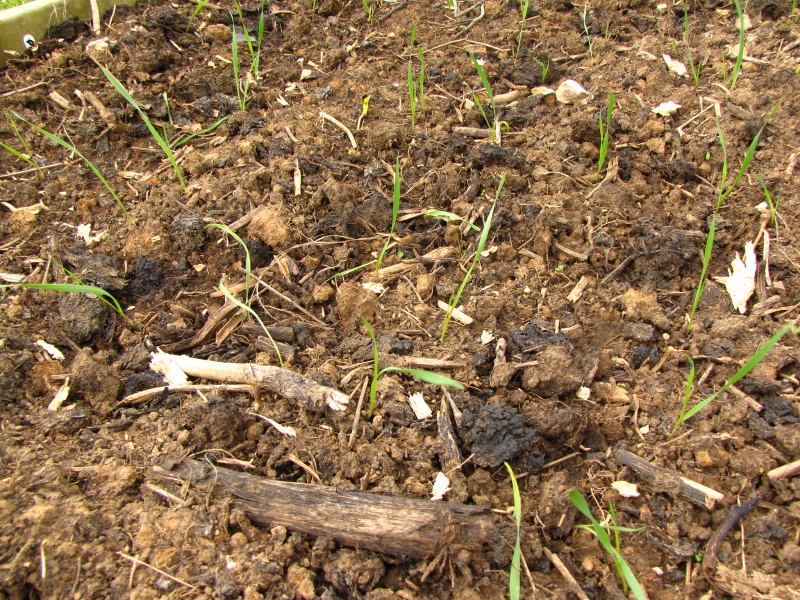
Germinated Wheat by British Red, on Flickr

Germinated Wheat by British Red, on Flickr
That the long stem wheat Hugh?
If it is, how long from germination to harvest is it approximately?
If it is, how long from germination to harvest is it approximately?
The wheat seems to be doing fairly well

Wheat End of May by British Red, on Flickr
Although weirdly none of the varieties germinated well in the first quarter of the bed? I'll need to understand that better - planting depth or drainage perhaps?
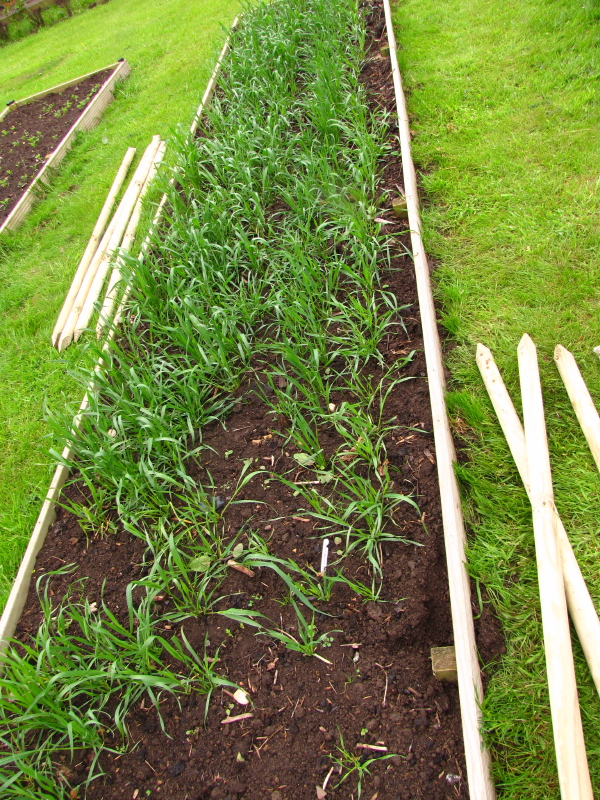
Wheat by British Red, on Flickr
Its been unseasonable windy so I knocked up a windbreak today. The reason for this is the wheat is in a narrow strip (only 4' wide) and some varieties grow up to 4 foot tall (far taller than modern wheat) plus of course the fens are windy!
Nothing fancy - a few tree stakes
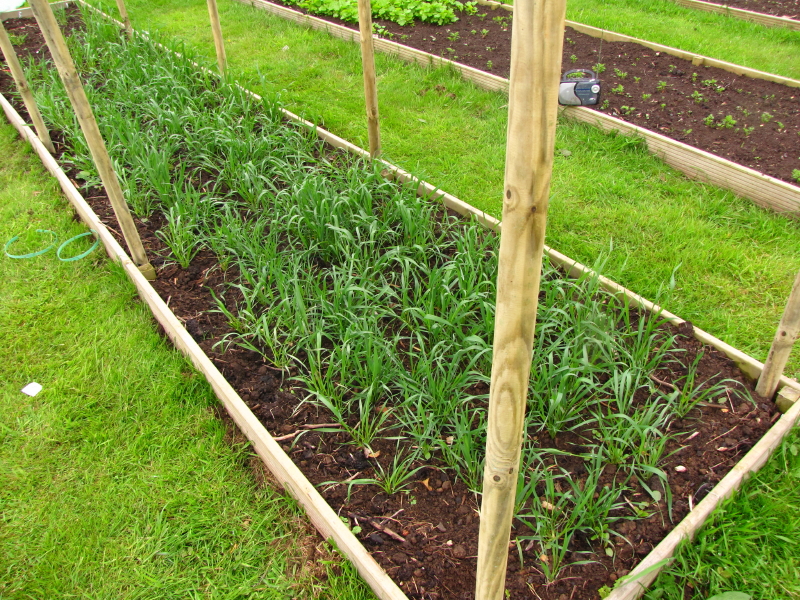
Tree Stakes Up by British Red, on Flickr
and some 4' tall scaffolding net
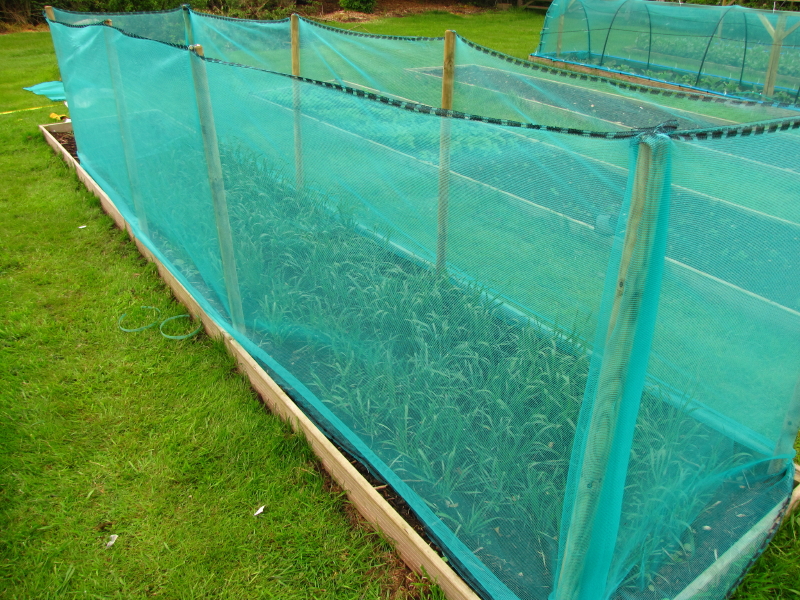
Wind break by British Red, on Flickr
I hope this will admit light but provide some support and break the wind. Hope is the operative word
More updates as they happen!
Red

Wheat End of May by British Red, on Flickr
Although weirdly none of the varieties germinated well in the first quarter of the bed? I'll need to understand that better - planting depth or drainage perhaps?

Wheat by British Red, on Flickr
Its been unseasonable windy so I knocked up a windbreak today. The reason for this is the wheat is in a narrow strip (only 4' wide) and some varieties grow up to 4 foot tall (far taller than modern wheat) plus of course the fens are windy!
Nothing fancy - a few tree stakes

Tree Stakes Up by British Red, on Flickr
and some 4' tall scaffolding net

Wind break by British Red, on Flickr
I hope this will admit light but provide some support and break the wind. Hope is the operative word
More updates as they happen!
Red
Just an update on the garden - its been a weird year for weather but we are getting there
Strawberries are flowering well - have fruit on and have been "strawed up". We have changed the mesh to 15mm on the tunnel this year as small birds get through the 1" mesh. 15mm lets the bees through but should keep all birds out
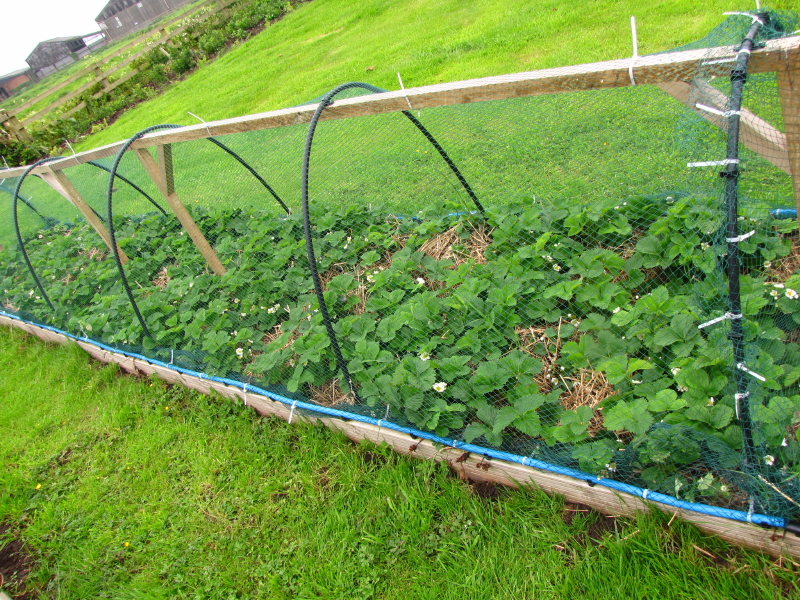
Strawberries by British Red, on Flickr
The (overwintered) onions are foing really well and loving the wet
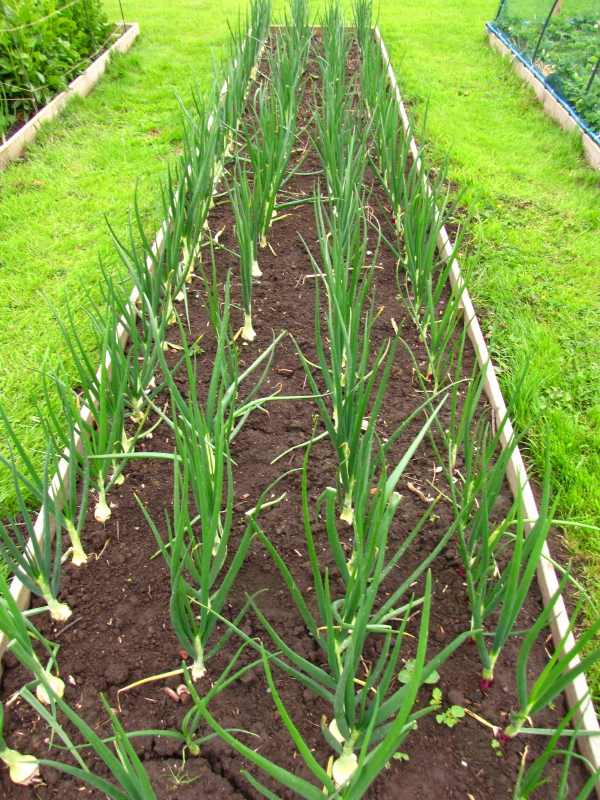
Onions by British Red, on Flickr
So is the garlic

Garlic by British Red, on Flickr
The sugar beet is flowering for seed saving

Sugar Beet Flowers by British Red, on Flickr
Parsnips are doing well but carrot germination is spotty

Parsnips and Carrots by British Red, on Flickr
Brussels are doing well - planted under fine mesh to keep the cabbage whites off and with calendual to minimise white fly and slug damage
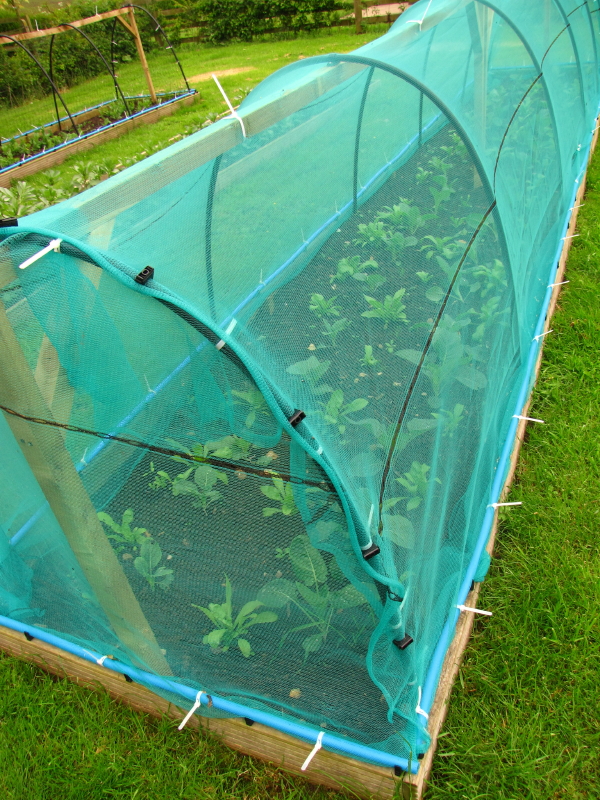
Brussel Sprouts by British Red, on Flickr
Field beans are coming on nicely - already flowering
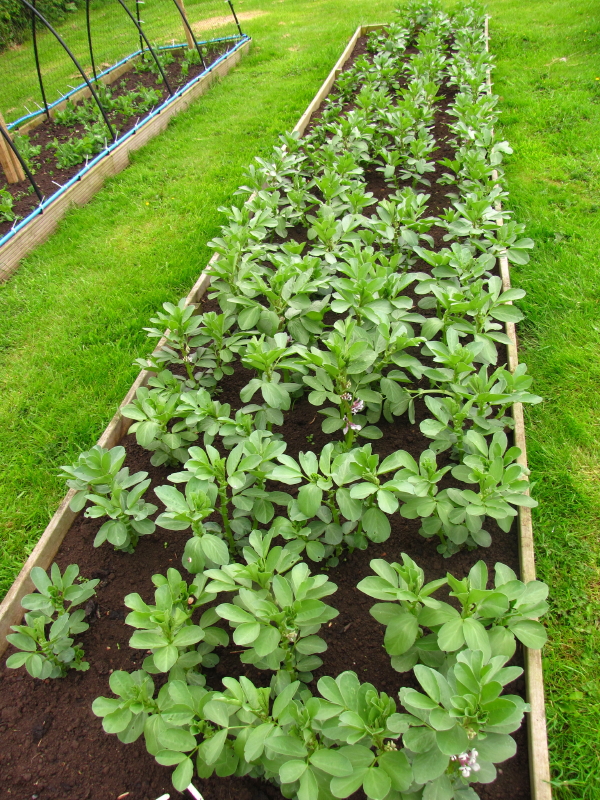
Wizard Field Beans by British Red, on Flickr
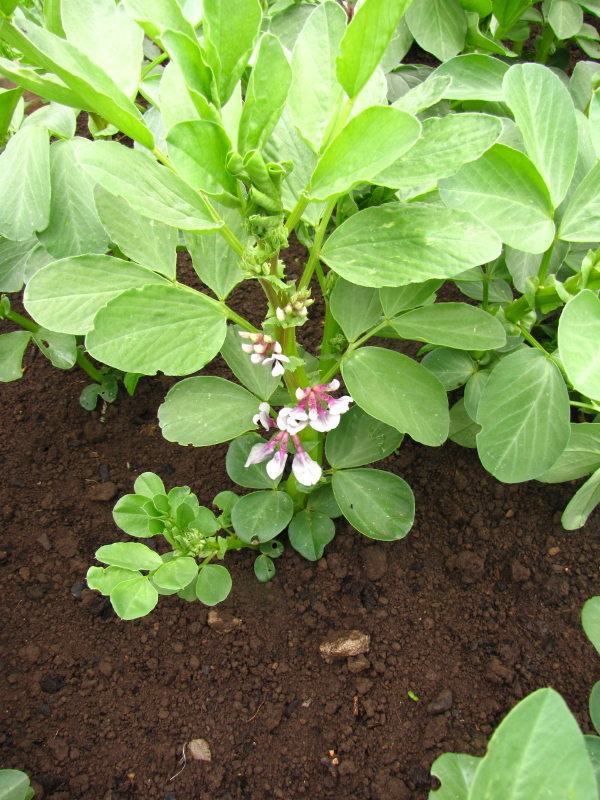
Field Bean Flowers by British Red, on Flickr
Early pea sowings got peigeoned to hell so re-sown under 2" mesh
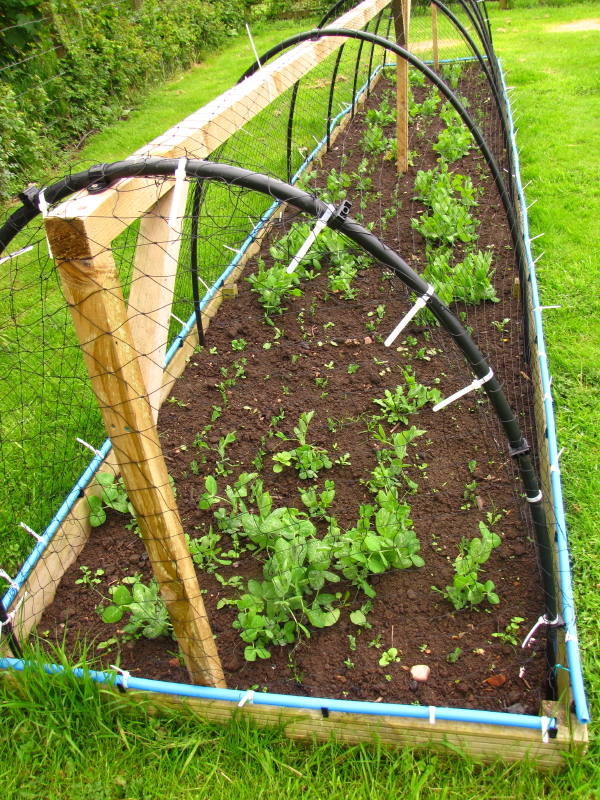
Pea Bed by British Red, on Flickr
Gooseberry layering went well and we ended up with two dozen new plants so we have extended the gooseberry bed
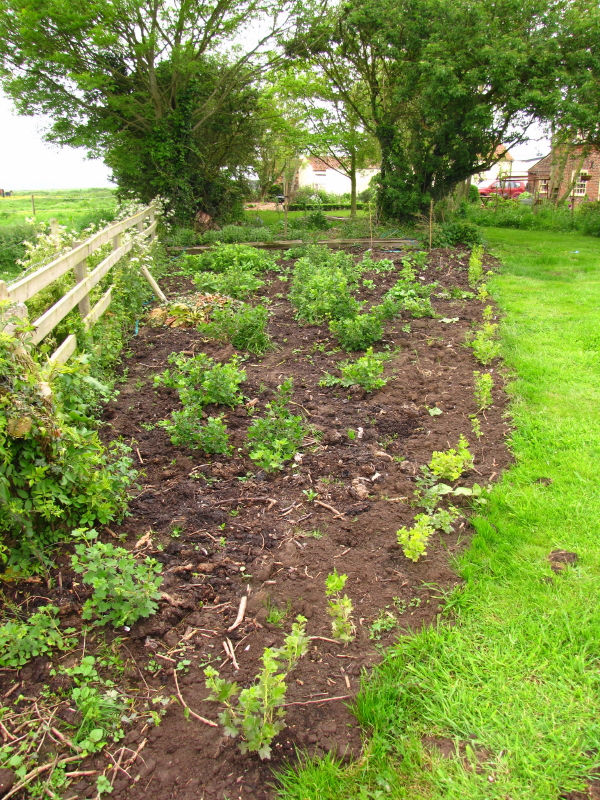
Gooseberry Bed by British Red, on Flickr
The new cherry trees seem to have blossomed in the odd bit of sun too - I wonder if the bees have helped?
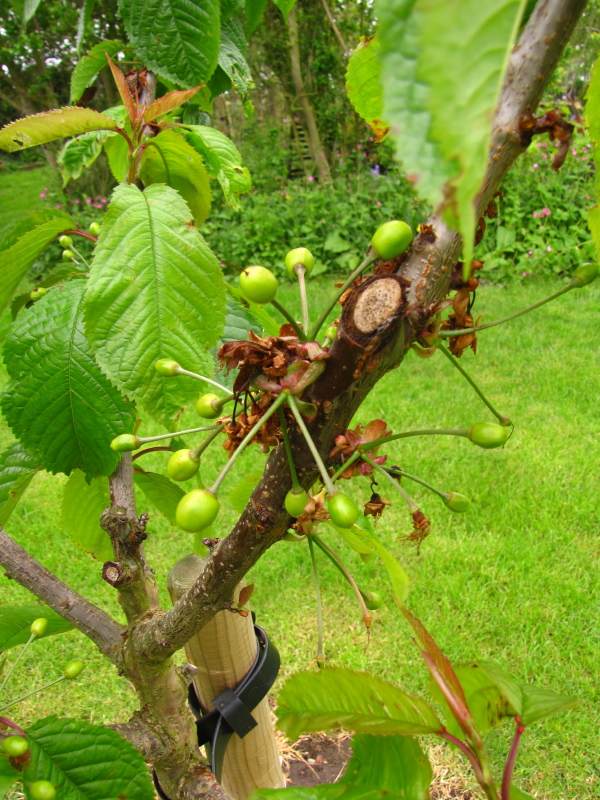
Cherries by British Red, on Flickr
Last year I grew a load of rhubarb from seed. It was surprisingly easy so I have made a new rhubarb bed
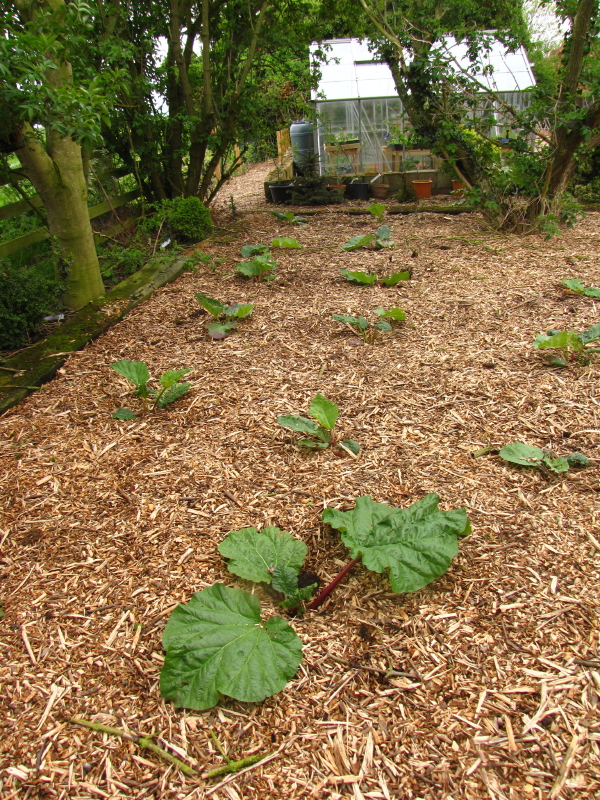
New Rhubarb Bed by British Red, on Flickr
to go with the old one

Old Rhubarb Bed by British Red, on Flickr
Toms, chillis and cucumbers all need some sun
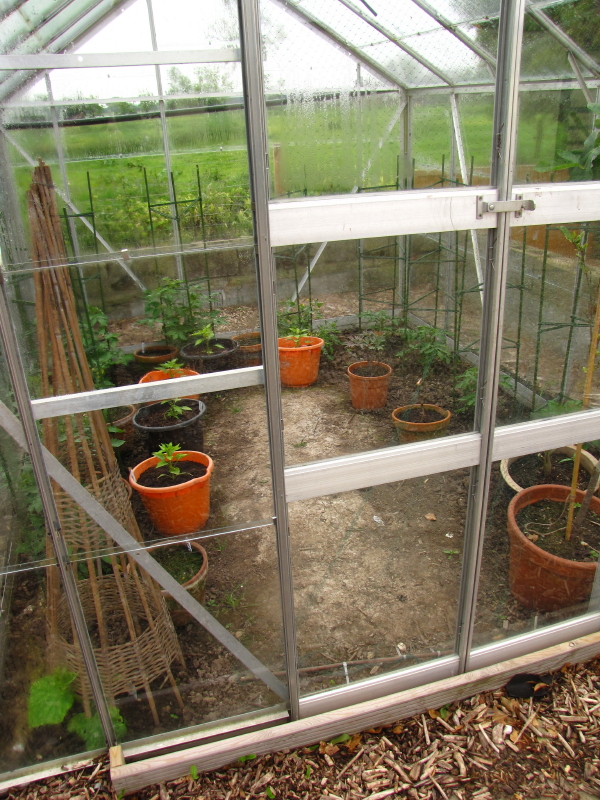
Tomatoes, Cucumbers and Chillis by British Red, on Flickr
and we are just about to plant out the brocolli under fine mesh (pigeon and butterfly protection)

Brocolli Cage by British Red, on Flickr
Thats it for now
Red
Strawberries are flowering well - have fruit on and have been "strawed up". We have changed the mesh to 15mm on the tunnel this year as small birds get through the 1" mesh. 15mm lets the bees through but should keep all birds out

Strawberries by British Red, on Flickr
The (overwintered) onions are foing really well and loving the wet

Onions by British Red, on Flickr
So is the garlic

Garlic by British Red, on Flickr
The sugar beet is flowering for seed saving

Sugar Beet Flowers by British Red, on Flickr
Parsnips are doing well but carrot germination is spotty

Parsnips and Carrots by British Red, on Flickr
Brussels are doing well - planted under fine mesh to keep the cabbage whites off and with calendual to minimise white fly and slug damage

Brussel Sprouts by British Red, on Flickr
Field beans are coming on nicely - already flowering

Wizard Field Beans by British Red, on Flickr

Field Bean Flowers by British Red, on Flickr
Early pea sowings got peigeoned to hell so re-sown under 2" mesh

Pea Bed by British Red, on Flickr
Gooseberry layering went well and we ended up with two dozen new plants so we have extended the gooseberry bed

Gooseberry Bed by British Red, on Flickr
The new cherry trees seem to have blossomed in the odd bit of sun too - I wonder if the bees have helped?

Cherries by British Red, on Flickr
Last year I grew a load of rhubarb from seed. It was surprisingly easy so I have made a new rhubarb bed

New Rhubarb Bed by British Red, on Flickr
to go with the old one

Old Rhubarb Bed by British Red, on Flickr
Toms, chillis and cucumbers all need some sun

Tomatoes, Cucumbers and Chillis by British Red, on Flickr
and we are just about to plant out the brocolli under fine mesh (pigeon and butterfly protection)

Brocolli Cage by British Red, on Flickr
Thats it for now
Red
Lovely garden Red. Puts my little patch to shame. Strawberries here are flowering too. Thanks for sharing.
Heh. I thought my strawberries were doing well.
First time I've seen this thread and I'm truly impressed BR. Well done on working so hard.
First time I've seen this thread and I'm truly impressed BR. Well done on working so hard.
you have a fair bit of garlic there Red, ? And your parsnips are way past mine.
Edit.
No runner beans ? The carrots of mine I think got caught in the late snow. Little seeds rot quickly, I had to reseed, I have about 8 up from the original sewing
Edit.
No runner beans ? The carrots of mine I think got caught in the late snow. Little seeds rot quickly, I had to reseed, I have about 8 up from the original sewing
Last edited:
you have a fair bit of garlic there Red, ? And your parsnips are way past mine.
Edit.
No runner beans ? The carrots of mine I think got caught in the late snow. Little seeds rot quickly, I had to reseed, I have about 8 up from the original sewing
I have re-seeded the carrots as well - in our case I think heavy rain disturbed the firm soil and then birds and frost got in. I haven't yet settled on a carrot strain I am truly happy with. We always do okay - but nothing I am really content with.
Its a years worth of garlic - we use quite a bit
Not a fan of the runner bean to be honest - I grow "trail of tears" Cherokee beans for the green bean - smaller, sweeter, prolific.
Thw parnsnips are our own strain of "tender and true" - its probably the seed we produce that I am most proud of, always reliable, hardy and prolific.
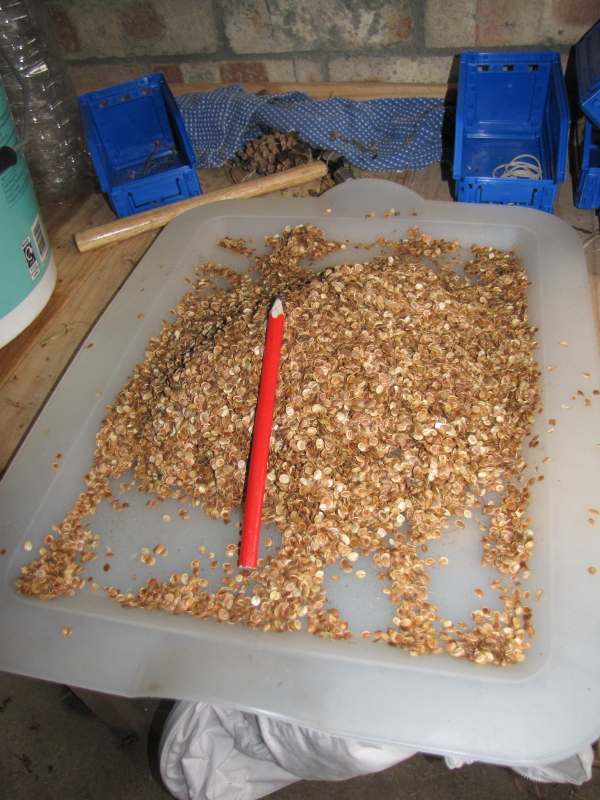
Parsnip Seed by British Red, on Flickr
I gave a lot of parsnip seed away to full members this year - I hope theirs does as well!
Its Radio 4 chattering away Robbi on my cheapo analogue "don't care if it gets rained on" radio 
Nothing better than some "Any questions" when weeding!
Nothing better than some "Any questions" when weeding!
I did a quick search on commercial carrot growing this spring to see how farmers grow them. One thing I remember is they grow them in furrowed fields to aid water management. I dont think they like sodden soil !
www.ces.ncsu.edu/hil/hil-9.html
www.ces.ncsu.edu/hil/hil-9.html
Excitement today - we have wheat ears!

Long Stem Wheat 20-6 by British Red, on Flickr
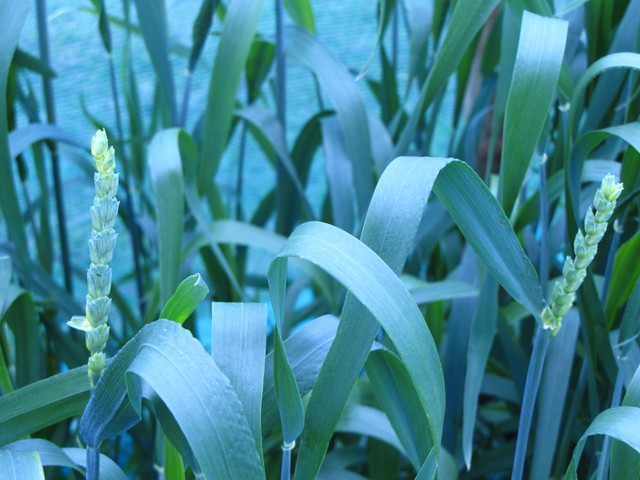
Long stem wheat ears by British Red, on Flickr
A long way to go yet...but at least it is forming ears. I'm hoping for it to grow quite a bit higher yet....the longer straw the better if I'm going to make skeps with it
I'm pleased to see the sugar beet is starting to flower in earnest too
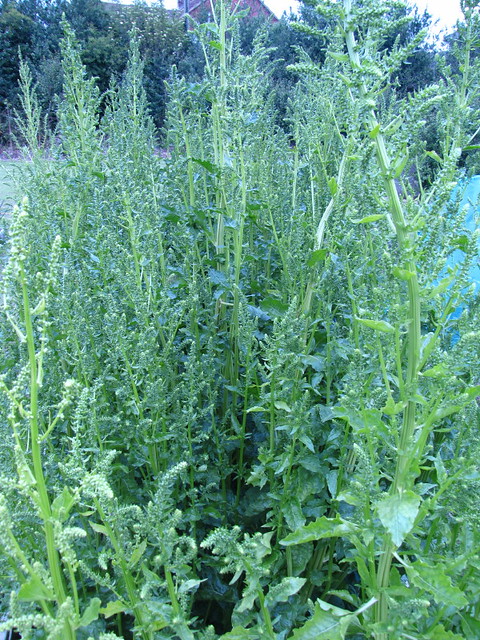
Sugar beet flowers June 2013 by British Red, on Flickr
....and the early cherries are now edible

Cherries June 2013 by British Red, on Flickr
although the later varieties have a way to go - which is nice giving us some succession

Cherries June 2013 by British Red, on Flickr
Red

Long Stem Wheat 20-6 by British Red, on Flickr

Long stem wheat ears by British Red, on Flickr
A long way to go yet...but at least it is forming ears. I'm hoping for it to grow quite a bit higher yet....the longer straw the better if I'm going to make skeps with it
I'm pleased to see the sugar beet is starting to flower in earnest too

Sugar beet flowers June 2013 by British Red, on Flickr
....and the early cherries are now edible

Cherries June 2013 by British Red, on Flickr
although the later varieties have a way to go - which is nice giving us some succession

Cherries June 2013 by British Red, on Flickr
Red
Similar threads
- Replies
- 3
- Views
- 164
- Replies
- 2
- Views
- 434
- Replies
- 2
- Views
- 308
